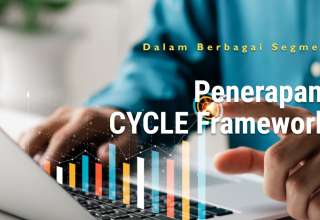*) Gambar sebagai ilustrasi
FINANCE Framework: A Strategic Model for Effective and Sustainable Financial Management
Developed by Mohamad Haitan Rachman
Introduction
Finance is the lifeblood of individuals, businesses, and organizations. Without proper financial management, both short-term and long-term goals become difficult to achieve. At the individual level, many people work hard but still feel their money disappears without direction. In business, especially SMEs and startups, cash flow problems are often the main cause of failure. At the organizational level, weak financial management can lead to inefficiency and reduce public trust.
To address these challenges, Mohamad Haitan Rachman developed the FINANCE Framework—a systematic model that helps manage finances comprehensively, from planning, execution, and control, to evaluation. FINANCE stands for Forecast, Identify, Negotiate, Analyze, Navigate, Control, Evaluate.
1. Forecast Needs
The first stage is Forecast. Every individual or organization must project financial needs, both short-term and long-term. Forecasting is not only about calculating numbers but also about defining priorities and vision.
For individuals, forecasts may include monthly expenses (food, transport, rent) and annual expenses (education, travel, or weddings). For businesses, forecasts involve revenue projections, operating costs, and capital requirements. For public organizations, forecasts cover annual budgeting and allocation for priority programs.
Without a clear forecast, financial management becomes reactive. With it, every financial step gains direction and purpose.
2. Identify Sources
The second step is Identify. Individuals often focus solely on salaries, ignoring other potential income such as freelance work, investments, or productive assets. For businesses, identifying revenue sources means mapping out product sales, services, subscriptions, or partnerships.
For NGOs or public organizations, income identification includes grants, sponsorships, and government support.
The goal is to clarify all inflows, creating a strong basis for allocation and strategy. The more diversified the income sources, the stronger the resilience against uncertainty.
3. Negotiate & Allocate
Once resources are clear, the next step is Negotiate & Allocate. Every income must be allocated according to priorities. One popular method is the 50-30-20 rule:
- 50% for necessities,
- 30% for savings/investments,
- 20% for leisure or lifestyle.
For businesses, this means distributing funds across production, marketing, HR, and product development. For public organizations, it involves dividing budgets into health, education, infrastructure, and other critical sectors.
This stage emphasizes balance between present needs and future preparation.
4. Analyze Spending
The fourth step is Analyze. After allocation, spending must be recorded and analyzed. Documentation provides a factual picture: are expenses aligned with plans, or is there overspending?
Individuals can use personal finance apps to log transactions. Businesses rely on financial reports such as income statements, cash flow, and balance sheets. Public organizations must ensure transparent records for auditing.
Analysis reveals spending patterns, inefficiencies, and opportunities for optimization. Ultimately, what cannot be measured cannot be managed.
5. Navigate Risks
No financial system is risk-free. Thus, the fifth step is Navigate. Individuals need an emergency fund equal to 3–6 months of living expenses and appropriate insurance coverage.
Businesses face risks such as market fluctuations, delayed payments, or rising input costs. Mitigation strategies may include supplier diversification, contracts, or cash reserves.
Public organizations face risks like corruption, inefficiency, or misuse of funds. Risk navigation here involves oversight mechanisms and independent audits.
By navigating risks, finances remain resilient amid uncertainty.
6. Control & Monitor
The sixth stage is Control. Financial management is not only about planning but also about discipline mechanisms to stay on track.
Individuals may conduct weekly reviews, set daily spending limits, and monitor balances regularly. Businesses rely on Key Performance Indicators (KPIs) such as current ratio, gross margin, or debt-to-equity ratio. Public organizations establish internal and external oversight systems.
Control acts as the “brake,” ensuring finances do not run unchecked. With proper monitoring, every expenditure becomes accountable.
7. Evaluate & Enhance
The final stage is Evaluate. Evaluation reviews whether financial strategies align with forecasts.
Individuals evaluate savings, investments, and spending patterns monthly. Businesses conduct quarterly or annual reviews through audits and management reports. Public organizations provide accountability reports to stakeholders.
Evaluation must be followed by enhancement—improving strategies for the next cycle. Thus, the FINANCE Framework creates a loop of continuous financial improvement.
Applications in Three Contexts
1. Individuals
- Forecast monthly and annual needs.
- Identify salary and side incomes.
- Allocate funds with the 50-30-20 rule.
- Analyze daily spending using apps.
- Navigate risks with emergency funds and insurance.
- Control expenses through weekly checks.
- Evaluate monthly performance.
2. SMEs/Startups
- Forecast sales and capital requirements.
- Identify revenue streams (products, services, subscriptions).
- Negotiate allocation for production, marketing, HR.
- Analyze income statements and cash flow.
- Navigate market and inventory risks.
- Control via financial KPIs.
- Evaluate with quarterly audits and reviews.
3. Public Organizations
- Forecast annual budgets.
- Identify funding sources (government, grants, sponsors).
- Negotiate allocations for priority sectors.
- Analyze public fund usage.
- Navigate risks of inefficiency and corruption.
- Control via robust oversight.
- Evaluate with transparent reporting.
Integration with Other Frameworks
The FINANCE Framework does not stand alone. It can be integrated with other models developed by Mohamad Haitan Rachman:
- INCOME & INVEST → building a cycle of earning, managing, and investing.
- SCORE & PERFORM → measuring financial strategy effectiveness.
- SYSTEM & DESIGN → designing scalable and sustainable financial systems.
Through such integration, FINANCE becomes part of the larger Negeri Framework ecosystem.
Conclusion
The FINANCE Framework is a strategic model for managing finances systematically and sustainably. With seven stages—Forecast, Identify, Negotiate, Analyze, Navigate, Control, Evaluate—it emphasizes planning, documentation, risk management, discipline, and continuous evaluation.
Developed by Mohamad Haitan Rachman, the FINANCE Framework serves not only as a technical guide but also as a philosophy of financial management that values health, transparency, and growth.
Ultimately, finance is not just about numbers. It is about how every unit of currency is managed to achieve stability, sustainability, and financial freedom.
If you have questions regarding training, mentoring, the analysis of the implementation of the FRAMEWORK, and the development of the systems we provide, as well as a desire for collaboration, please contact us through haitan.rachman@inosi.co.id.


